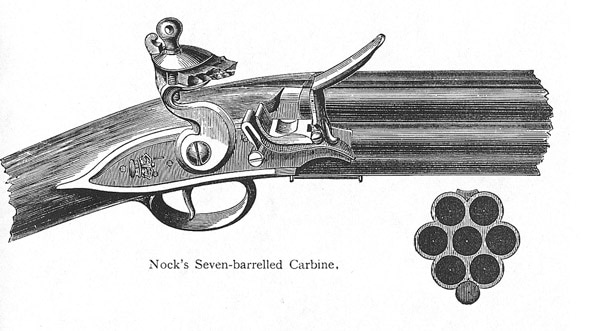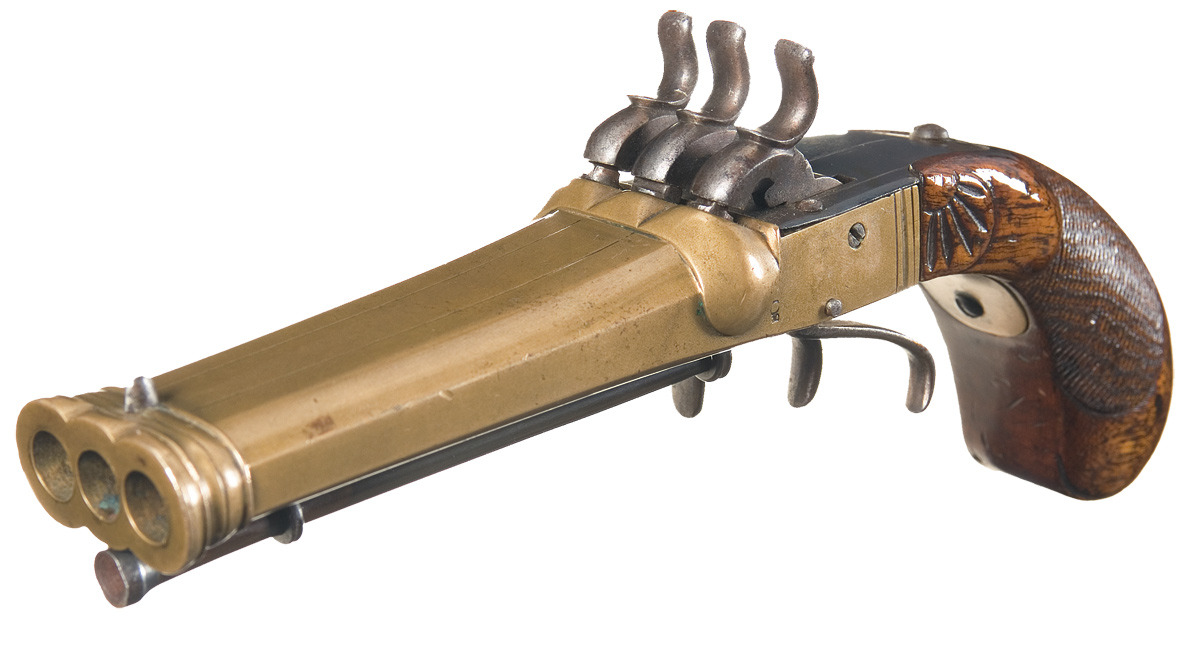Archive
Day-After-Monday Gun Day
Yes, I missed it by a day, but I have an excuse.

Well, none of those, but still. It’s the holidays, it’s 2020, I’ve had a lot on – and most important of all, I only just saw this, like, five minutes ago. So there.
Anyway, I’m sure there are player characters everywhere who would love a little toy like this:

It’s a gun made for Francesco Morozini, Duke of Venice (1619-1694). You pull the silk bookmark to shoot while the book is closed.
It’s clearly a flintlock, and it looks to be a good enough size to count as a standard pistol in most rulesets. The barrel is on the short side so it won’t be terribly accurate over longer ranges, but within a few feet it should be just fine. And that, after all, is why it’s hidden in a book: so you can get close without arousing suspicion.
More Like This
Hidden Weapons: Pay attention, 007!
Multi-Barrel Weapons: What’s better than a gun? Lots of guns.
Combi-Weapons: Now you can bring a knife to a gunfight.
Monday Gun Day, Part 2: Combi-Weapons
There’s an old saying about bringing a knife to a gunfight, but the painfully slow reload rates of black-powder firearms made it advisable to have a backup weapon. Some attempts were made to combine the two: bayonets became the most popular solution, but there were quite a few attempts to build pistols into melee weapons of various kinds.
These included swords:

Daggers:

Axes:

And warhammers.

In a roleplaying game, a combi-weapon is a one-shot firearm. Most would be pistols, though some, attached to two-handed weapons, might count as larger firearms. They reduce the time needed to switch weapons, perhaps to no time at all. However, they have some significant drawbacks:
In the first place, they are not generally available. Almost all will have to be made to order, which takes both time and money. The cost will be at least twice the sum of the cost of the two base weapons, and the same is true of the time needed.
An artisan charged with making a combi-weapon must be skilled as a gunsmith as well as a bladesmith. All skill rolls involved in making a combi-weapon carry a significant penalty.
The finished article represents the worst of both worlds. It is heavy and awkward to aim, and ill-balanced for close combat. In game terms, the very best combi-weapons, made by master artificers (even Dwarves!) can never be better than average quality. Most are inferior, and if your game system has a way to rate quality, a combi-weapon is at least two quality steps below the normal level of quality produced by the artisan who made it. There are attack penalties, an increased chance of misfires, and the weapon is weaker overall, meaning that it is more easily damaged in combat if your rules set covers damage to weapons.
That said, though, it can give a wielder the advantage of surprise. An unexpected gunshot at the start of a fight can unnerve the enemy, who will be left wondering what other tricks the character might have up his or her sleeve. Enemies will be warier, even if they don’t mean to be, adopting a more defensive, cautious stance. How this is handled in a game’s rules is a matter for the GM to decide. Especially skittish foes may have to make Fear checks to get over the surprise of a combi-weapon firing, running away if they fail.
So there you have it – and you can see why they didn’t really catch on. Still, I can imagine some players’ eyes lighting up at the thought of a sword that is also a gun, and you can have a lot of fun if the party decides to track down an artisan capable of making such a weapon and persuade them to try.
More Like This
Multi-Barrel Weapons: What’s better than a gun? Lots of guns.
Hidden Weapons: Pay attention, 007!
Monday Gun Day: Multi-Barrel Weapons
The “Bling” post on ring guns was well received, so here are a few more interesting and surprising guns for your black-powder fantasy games.
Before metal cartridges were invented in the 19th century, reloading was a major limiting factor on a gun’s usefulness. One idea to mitigate the problem was the development of multi-barreled weapons. They fall into two broad classes: volley guns, where all the barrels fire at once; and single-fire guns.
Volley Guns
Volley guns can do a lot of damage, but reloading takes a very long time and the recoil of so many barrels firing at once can injure the user. To make things worse, some designs allow misfires to cascade from one barrel to the others, turning the weapon into a fragmentation grenade held right by the user’s cheek. A few years ago I wrote an article on the 19th-century Nock Volley Gun for Pyramid magazine, which includes rules for GURPS.
Here is a video of a Nock gun firing.

Duck-Foot Pistols
True to their name, duck-foot pistols have 3-5 barrels that splay out like the toes of a duck’s foot. They may be useful in a one-against-many situation – for example, a ship’s captain faced with a mutinous crew – but historically they were more intimidating than deadly. The recoil from three to five barrels whose caliber could be as much as .50 was considerable.
Here is a typical duck-foot, listed as .52 caliber.

Here is a video that goes into more detail.
With eight barrels, a mini-bayonet, and a spiked club pommel, this duck-foot certainly gives its user a lot of options!

Single-Fire Guns
Some single-fire guns (I don’t know if there’s a better term for a multi-barrelled firearm where the barrels fire one at a time, but if there is, please let me know!) have multiple triggers like a double-barrelled shotgun, if there are not too many barrels. They can be fired one at a time or in a both-barrels volley.
This pistol is three guns in one.

Others anticipate the design of the revolver by having a single trigger and firing mechanism, and rotating the cluster of barrels to fire them in succession. Depending on the game system, the act of moving a new barrel into line may require a short action, or it may be free. “Pepperbox” pistols, as they were called, were first made in the 1500s and by the 19th century they could have as many as 24 barrels.

While their recoil is not as dangerous as that of a volley gun, these weapons were still heavier than their single-barrelled counterparts, making them harder to raise and aim. Depending on the rules set you use, some kind of strength check might be required to avoid a penalty to hit.
For WFRP fans, Cubicle 7 recently re-released the 1st edition Warhammer Companion, which includes an article on duck-foot and other interesting gunpowder weapons. You can get it from DriveThruRPG.com. Maybe one day when I have a little more time I’ll do a new version for WFRP 4th edition.
More Like This
Combi-Weapons: Now you can bring a knife to a gunfight.
Hidden Weapons: Pay attention, 007!
My Top Five Monster Books (that I worked on)
In an earlier post, I wrote about my love for monsters and picked out a few of my favorite rpg monster books. A lot of you got back to me with your own favorites, either in the comments section or through Facebook or other means, and now I have quite a few more books to look at – so thanks for that!
This time, I’ll be looking at some monster books that I’ve written or co-written. I’ll explain what I hoped to achieve with each one, and you can judge for yourselves how well I succeeded or failed. As always, I’d love to have your thoughts on each one, especially what you think would have made it better.
There’s more to this request than simple nostalgia, or a need for validation. You see, I’m gearing up for a new project (more than one, in fact: #secretprojects) and I’m studying previous rpg monsters books to figure out what features turn a good one into a great one. I’ll be issuing a formal announcement about the project some time in the next few weeks, but until then, tell me what would make a monster book irresistible to you. What are the must-haves, what are the cut-aboves, and what are the mind-blowing, come-look-at-this, can-you-believe-it features that turn a monster treatment into something that you have to use as soon as you can, and that you will talk about for the rest of your gaming career?
Creatures of Freeport

https://greenroninstore.com/products/creatures-of-freeport-pdf
A great attraction of this project was the opportunity to work with my friend Keith Baker. Before Keith created Eberron, Gloom, and the other games that have made him rightly famous, we worked together in a video game studio in Boulder, Colorado. We were both impressed by Green Ronin’s Freeport setting: I mean, D&D with pirates – what’s not to love? I had been thinking of ways to expand and improve the way monsters are covered in tabletop rpgs ever since my Games Workshop days, and Keith was a whiz at the complex process of creating monster stats for the 3.5/d20 system.
We added three sections to the standard treatment. The first set out the kind of information about the creature that might be available on a successful knowledge check, the second covered various magical, alchemical, and other uses for the dead creature’s remains, and the third presented a selection of adventure hooks.
The book got some good reviews, and we were both quite happy with it. But I’m still left with the feeling that it is possible to do better.
Atlas of the Walking Dead

https://www.drivethrurpg.com/product/566/Atlas-of-the-Walking-Dead?affiliate_id=386172
Eden Studios’ zombie survival-horror game All Flesh Must Be Eaten came out just at the start of that heady (brain-y?) period in which zombie horror began to take over the zeitgeist. Since the undead have always been one of my favorite classes of monsters, I jumped at the chance to pitch them a monster book.
I took myth and folklore as my starting point here. Over the years, I had read an enormous amount on the subject, especially on the creatures of folklore around the world. I found that the walking dead – which I defined as all kinds of corporeal undead, not just zombies – broke down into a number of classes, with variants from different parts of the world. For each type, I started with a short piece of atmospheric fiction to set the scene, defined the base creature in terms of the game’s rules, and added a short section on variants. In many cases it was necessary to define new traits (Aspects in the game’s lingo), and as in Creatures of Freeport I finished up with a selection of adventure hooks.
GURPS Faerie

http://www.sjgames.com/gurps/books/faerie/
Like all the GURPS worldbooks, this was as much a setting as a bestiary. Faeries are found across the world under a range of local names, and like the walking dead they break down into a number of distinct types. In addition to chapters on faerie lands, faerie magic, and faerie nature, I wrote a chapter of templates for the various types with variants on each. Following the format established by previous monster-centric sourcebooks for GURPS, a chapter on campaigns and adventures took the place of adventure seeds per template.
I like this book because faeries are another favorite class of monsters, and because it allowed me to examine their folkloric context in greater depth than a bestiary-style book would have permitted. Faerie is a tone as much as a class of monster, with its own feel and its own tropes, and to neglect this would have been to do the subject matter a grave injustice – and who knows, possibly to suffer spoiled milk and bedbugs for the rest of my life!
Werewolves: A Hunter’s Guide

https://ospreypublishing.com/werewolves-a-hunter-s-guide
Is this an rpg monster book, really? There’s not a rule or a game stat in sight, but I think of all the Dark Osprey line as systemless rpg sourcebooks. I took the example set by line editor (and future designer of the excellent fantasy skirmish game Frostgrave) Joe McCullough in his book Zombies: A Hunter’s Guide, and set my werewolf book in the same alternate reality.
Although I already knew quite a bit about werewolves, the research for this book led me to the conclusion that there are at least five distinct kinds. Each one got a chapter, supported by case studies drawn (mostly) from genuine historical and mythological sources, and I took a couple of chapters to shoot a glance at other shapeshifters (such as Japanese hengeyokai and Indian weretigers) and to invent various organizations that hunt and/or study werewolves. Of course, I covered werewolves at war, from Norse ulfhednar to the ever-popular Nazi werewolves and various Cold War spin-offs from Nazi research in that area.
The viewpoint is from contemporary urban fantasy rather than medieval fantasy, but that made a nice change, and I didn’t think that it lessened the book’s usefulness for rpgs set in any time or place. It is not aimed at any particular rules set, so there is some work for the GM to do, but I still hope that it offers a good source of information and ideas.
Colonial Gothic Bestiary

https://www.rogue-games.net/bestiary
Colonial Gothic is a very nice historical-fantasy game published by Rogue Games. I met Rogue’s head honcho Richard Iorio years ago when we were both working on the Hogshead Publishing booth at GenCon, and when he published Colonial Gothic I got in touch. A solid monster book is an essential part of an rpg’s core, and I aimed to provide one in the Colonial Gothic Bestiary.
As monster books go, it’s fairly unambitious. The aim was to cover a large number of critters and provide the GM with options, rather than to look at a smaller number in detail. What I like most about it is the way that it reflects the setting in its blend of North American wildlife, Native American folklore monsters, fearsome critters from tall tales, and Old World monsters that might believably have come across with the colonists.
So there you have it – or them. I will look forward to hearing your views, and discussing what features make a monster treatment really shine. And as soon as I can, I’ll be lifting the curtain on my #secretprojects. Bye for now!
Thor the Thunderer
If you’re a wargamer or a military history geek, you will have heard of Osprey books. Chances are you’ll own a few.
So imagine how pleased I was when Osprey contacted me out of the blue to write for their new Osprey Adventures series. Apparently my work on GURPS Vikings and Medieval: Total War – Viking Invasion impressed someone there, because they asked me to write a book on the most popular of the Norse gods, Thor the Thunderer.
Osprey Adventures is a fairly new series, adding mythology to Osprey’s already impressive coverage of history. I was flattered that they asked me to write one of the first titles. I recently finished a second book in a different series, but I can’t talk about it yet. Watch this space….





